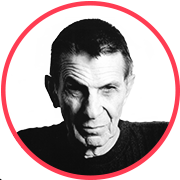Expertise: Leonard Nimoy’s Photography

Leonard Nimoy started doing photography when he was a teen. His first darkroom was located in the bathroom of the apartment where he lived with his parents. He began shooting friends and family members, then went to study at the University of California in Los Angeles, learning from artist and photographer Robert Heinecken.
In 1973 Nimoy held his first exhibition. In 2003 after decades of work in movie industry, Nimoy decided to go back to photography. Talking about the transition from analog to digital photography with Huffington Post Nimoy said, “For me, getting out of the darkroom is a revelation. I’m out in the sunlight! I’m working with light instead of dark, so I’m comfortable with the transition. The new work was all done digitally – and we chose a very high-resolution, very sophisticated piece of equipment, a Hasselblad digital camera.”
{ “img”: “/wp-content/uploads/2014/12/nimoy_01.jpg”, “alt”: “Expertise: Leonard Nimoy’s Photography 1”, “text”: “Photo by Leonard Nimoy” },
{ “img”: “/wp-content/uploads/2014/12/nimoy_02.jpg”, “alt”: “Expertise: Leonard Nimoy’s Photography 2”, “text”: “Photo by Leonard Nimoy” },
{ “img”: “/wp-content/uploads/2014/12/nimoy_03.jpg”, “alt”: “Expertise: Leonard Nimoy’s Photography 3”, “text”: “Photo by Leonard Nimoy” },
{ “img”: “/wp-content/uploads/2014/12/nimoy_04.jpg”, “alt”: “Expertise: Leonard Nimoy’s Photography 4”, “text”: “Photo by Leonard Nimoy” },
{ “img”: “/wp-content/uploads/2014/12/nimoy_05.jpg”, “alt”: “Expertise: Leonard Nimoy’s Photography 5”, “text”: “Photo by Leonard Nimoy” },
{ “img”: “/wp-content/uploads/2014/12/nimoy_06.jpg”, “alt”: “Expertise: Leonard Nimoy’s Photography 6”, “text”: “Photo by Leonard Nimoy” },
{ “img”: “/wp-content/uploads/2014/12/nimoy_07.jpg”, “alt”: “Expertise: Leonard Nimoy’s Photography 7”, “text”: “Photo by Leonard Nimoy” }

Leonard Nimoy was a thinker and a creative. He used photography to explore his thoughts. His photographs tend to focus on people and are often confined within the four walls of a studio. Many of his subjects are female and often they are nude. There is nothing prurient about his images – he is seeking beauty where it is often overlooked. For example, in his series “The Full Body Project” he photographs larger women and asks questions such as, “How do they feel about themselves?” There is nothing judgmental about the portraits and the women in the frame are beautiful and encourage you to stare and admire their form.
He uses varying techniques and styles to bring issues such as identity into the light. In his series “Secret Selves” he gathered 100 subjects from all walks of life: artists, clergy, politicians, business owners, and asked them the question, “Who do you think you are?” The images are playful and colorful. Sometimes humorous and sometimes surprising. He is examining masks and the fact that we all have multiple personalities which was also the focus of Grayson Perry in his recent Channel 4 documentary “Grayson Perry: Who Are You?” At first glance you might be forgiven that the images are slightly tacky however you soon realize that Nimoy has skill and is learned. The photographs might be slightly garish but they are composed well and with depth.
{ “img”: “/wp-content/uploads/2014/12/nimoy_08.jpg”, “alt”: “Expertise: Leonard Nimoy’s Photography 8”, “text”: “Photo by Leonard Nimoy” },
{ “img”: “/wp-content/uploads/2014/12/nimoy_09.jpg”, “alt”: “Expertise: Leonard Nimoy’s Photography 9”, “text”: “Photo by Leonard Nimoy” },
{ “img”: “/wp-content/uploads/2014/12/nimoy_10.jpg”, “alt”: “Expertise: Leonard Nimoy’s Photography 10”, “text”: “Photo by Leonard Nimoy” },
{ “img”: “/wp-content/uploads/2014/12/nimoy_11.jpg”, “alt”: “Expertise: Leonard Nimoy’s Photography 11”, “text”: “Photo by Leonard Nimoy” },
{ “img”: “/wp-content/uploads/2014/12/nimoy_12.jpg”, “alt”: “Expertise: Leonard Nimoy’s Photography 12”, “text”: “Photo by Leonard Nimoy” },
{ “img”: “/wp-content/uploads/2014/12/nimoy_13.jpg”, “alt”: “Expertise: Leonard Nimoy’s Photography 13”, “text”: “Photo by Leonard Nimoy” },
{ “img”: “/wp-content/uploads/2014/12/nimoy_14.jpg”, “alt”: “Expertise: Leonard Nimoy’s Photography 14”, “text”: “Photo by Leonard Nimoy” },
{ “img”: “/wp-content/uploads/2014/12/nimoy_15.jpg”, “alt”: “Expertise: Leonard Nimoy’s Photography 15”, “text”: “Photo by Leonard Nimoy” },
{ “img”: “/wp-content/uploads/2014/12/nimoy_16.jpg”, “alt”: “Expertise: Leonard Nimoy’s Photography 16”, “text”: “Photo by Leonard Nimoy” },
{ “img”: “/wp-content/uploads/2014/12/nimoy_17.jpg”, “alt”: “Expertise: Leonard Nimoy’s Photography 17”, “text”: “Photo by Leonard Nimoy” }
In the “Eye Contact” series he explores contact and connection with his subjects using a different set of tools. Nimoy’s shed obviously has lots of tools, or cameras, hanging along the wooden panels. He photographed the models using studio lights and in black and white. Again there is the slightest touch of crudity or primitiveness however there is also a stronger touch of Imogen Cunningham and even Todd Hido. I say this because of the way he plays with light, contrast and form.
I like the fact that so many well known faces enjoy photography – it reflects the fact that people in general love photography. It is sometimes described as lazy painting which isn’t a fair description but it highlights that fact that it is an accessible art form. It is an opportunity for anyone to create and explore with ease and express themselves without the use of words. Leonard Nimoy is an accomplished photographer. His end results aren’t particularly to my taste but I can really appreciate his talent, his eye, his thoughtfulness, his playfulness and above all – his creativity.
{ “img”: “/wp-content/uploads/2014/12/nimoy_18.jpg”, “alt”: “Expertise: Leonard Nimoy’s Photography 18”, “text”: “Photo by Leonard Nimoy” },
{ “img”: “/wp-content/uploads/2014/12/nimoy_19.jpg”, “alt”: “Expertise: Leonard Nimoy’s Photography 19”, “text”: “Photo by Leonard Nimoy” },
{ “img”: “/wp-content/uploads/2014/12/nimoy_20.jpg”, “alt”: “Expertise: Leonard Nimoy’s Photography 20”, “text”: “Photo by Leonard Nimoy” },
{ “img”: “/wp-content/uploads/2014/12/nimoy_21.jpg”, “alt”: “Expertise: Leonard Nimoy’s Photography 21”, “text”: “Photo by Leonard Nimoy” },
{ “img”: “/wp-content/uploads/2014/12/nimoy_22.jpg”, “alt”: “Expertise: Leonard Nimoy’s Photography 22”, “text”: “Photo by Leonard Nimoy” },
{ “img”: “/wp-content/uploads/2014/12/nimoy_23.jpg”, “alt”: “Expertise: Leonard Nimoy’s Photography 23”, “text”: “Photo by Leonard Nimoy” },
{ “img”: “/wp-content/uploads/2014/12/nimoy_24.jpg”, “alt”: “Expertise: Leonard Nimoy’s Photography 24”, “text”: “Photo by Leonard Nimoy” },
{ “img”: “/wp-content/uploads/2014/12/nimoy_25.jpg”, “alt”: “Expertise: Leonard Nimoy’s Photography 25”, “text”: “Photo by Leonard Nimoy” },
{ “img”: “/wp-content/uploads/2014/12/nimoy_26.jpg”, “alt”: “Expertise: Leonard Nimoy’s Photography 26”, “text”: “Photo by Leonard Nimoy” },
{ “img”: “/wp-content/uploads/2014/12/nimoy_27.jpg”, “alt”: “Expertise: Leonard Nimoy’s Photography 27”, “text”: “Photo by Leonard Nimoy” },
{ “img”: “/wp-content/uploads/2014/12/nimoy_28.jpg”, “alt”: “Expertise: Leonard Nimoy’s Photography 28”, “text”: “Photo by Leonard Nimoy” }
New and best




